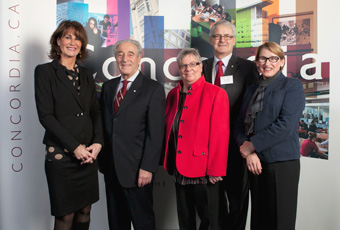Building innovation
Buildings account for 53 per cent of Canada’s energy consumption. But what if, instead of greedily sucking power from the grid, the structures we live and work in could produce enough energy to meet their own needs?
In the basement of the Henry F. Hall Building, a team of engineers is testing materials that may one day make that possibility a universal reality.
Concordia recently inaugurated its impressive new Solar Simulator – Environmental Chamber, built with a $4.6-million grant through the Knowledge Infrastructure Program (KIP), jointly funded by the Government of Canada and Quebec’s Ministère du développement économique, de l’innovation et de l’exportation.

The new lab allows researchers to test solar energy systems and building envelopes under simulated environmental conditions, drastically cutting down the amount of time and effort needed to acquire test results. Instead of having to wait months for specific conditions to occur outside, researchers can replicate them in the lab within a few hours.
The lab represents a major boost for solar energy and building innovation research at Concordia, says Professor Andreas Athienitis from Concordia’s Department of Building, Civil and Environmental Engineering. “This is like Santa Claus came and brought a lot of high-tech toys that will allow us to conduct the best research possible.”
The ceremony to inaugurate the new Solar Simulator – Environmental Chamber also marked the launch of the Natural Sciences and Engineering Research Council of Canada (NSERC) Smart Net-zero Energy Buildings strategic Research Network (SNEBRN). The network, which brings together government and industry partners and 29 researchers from 15 Canadian universities, will receive $5 million in funding from NSERC over five years, and additional funding from industry partners.
Athienitis is the scientific director of the SNEBRN, which is headquartered at Concordia — testament to the university’s key role in developing new green energy systems for buildings.
He says the network’s goal is to make the concept of net-zero energy buildings, buildings that produce as much energy as they need, a reality for the Canadian building industry, and to set a precedent for the rest of the world. “Our vision is to perform the research that would facilitate widespread production in key regions of Canada by 2030 of optimized net-zero energy building concepts.”

Concordia students taking part in the network’s research projects will greatly benefit from being part of the knowledge-sharing network, Athienitis insists, adding that they will become the industry leaders who will push net-zero energy buildings into the marketplace. “In doing our research over the next five years, we will train the leaders that are needed to achieve this transformation, and create a culture of acceptance, innovation and collaboration between universities, government and industry.”
Concordia’s Vice-President, Research and Graduate Studies, Louise Dandurand said the new Solar Simulator – Environment Chamber research project is “the culmination of a dream to house top researchers in innovative laboratory settings, and to give them access to the best equipment and personnel.” She said the facility guarantees that Concordia will continue to be a leader and an innovator in the field.
During his address to the crowd assembled in the D.B. Clarke Theatre for the inauguration, Concordia President Frederick Lowy underlined the importance of the innovative research being conducted in the Solar Simulator – Environmental Chamber, both for Canada’s economy and its environment. “The research that will be conducted at Concordia and throughout the network has the potential to produce great benefits for the wider society and for the ecology of the planet,” he said.

NSERC created its strategic networks program to help researchers produce innovative solutions to real-world problems. The SNERBN was awarded funding through the program on the strength of a previous network led by Concordia’s research team, known as the Solar Building Research Network (SBRN). It was largely as a result of its research successes that NSERC decided to award an additional five years of funding through the new network.
“They have very lofty goals and we’re very happy about that,” said NSERC’s President Suzanne Fortier. “We know they will be successful because they have an incredible track record.”
Proof of the research successes at Concordia in solar energy and innovative building envelopes in recent years is evident atop the university’s John Molson School of Business (JMSB) Building. A large black rectangular building-integrated photovoltaic/thermal system crowning the building provides much of its heat and energy. It’s the first system of its kind that is fully integrated into the building’s design and structure.
“The Solar Simulator – Environmental Chamber became possible largely based on the success of the SBRN and the JMSB solar building demonstration project,” Athienitis said.
Meanwhile, in the new research space, graduate students are already busy conducting experiments to design systems for integration into the buildings of tomorrow. And the best part? They don’t have to venture out into the cold to run their experiments.
“I’ve heard stories about a PhD student having to shovel snow in the middle of the winter, waiting for a sunny day so his PV (photovoltaic) panel would be exposed to the sun, and (only then) could he conduct his experiment,” said Yichao Chen, a graduate student in the Department of Building, Civil and Environmental Engineering. “It’s definitely a lucky time for me to be here.”
Related links:
• “Funding opens doors to research” — NOW, November 9, 2011
• “A Simulating Environment” — Concordia Engineering News, Winter 2010
• Solar Simulator — Environmental Chamber
• Knowledge Infrastructure Program — Concordia projects
• Department of Building, Civil and Environmental Engineering
• SNEBRN
• NSERC